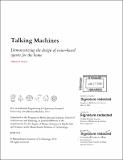| dc.contributor.advisor | Cynthia Breazeal. | en_US |
| dc.contributor.author | Singh, Nikhita | en_US |
| dc.contributor.other | Program in Media Arts and Sciences (Massachusetts Institute of Technology) | en_US |
| dc.date.accessioned | 2018-11-15T16:36:06Z | |
| dc.date.available | 2018-11-15T16:36:06Z | |
| dc.date.copyright | 2018 | en_US |
| dc.date.issued | 2018 | en_US |
| dc.identifier.uri | http://hdl.handle.net/1721.1/119089 | |
| dc.description | Thesis: S.M., Massachusetts Institute of Technology, School of Architecture and Planning, Program in Media Arts and Sciences, 2018. | en_US |
| dc.description | Cataloged from PDF version of thesis. | en_US |
| dc.description | Includes bibliographical references (pages 169-173). | en_US |
| dc.description.abstract | Embodied voice-based agents, such as Amazon Echo, Google Home, and Jibo, are becoming increasingly present in the home environment. For most people, these agents represent their first experience living with artificial intelligence in such private and personal spaces. However, little is known about people's desires, preferences, and boundaries for these technologies. This thesis shares insights, learnings, methods, and tools from a journey with 69 children, adults, and older adults to help democratize the design of voice-based agents for the home. In the first study, participants interact with and discover various voice-based agents to capture first impressions of the technology. In the second study, participants engage in long-term encounters with agents in their home to experience and reflect upon their preferences, desires and boundaries for these devices. Qualitative and quantitative data from interview transcripts, card sorting, and deployed cultural and technology probes is used to identify agent action preferences, sociotechnical themes, daily usage trends, personality preferences, and future "wishes" for agents. This work culminates with participants designing their dream agents for the home through a structured ideation process. Throughout this work, a series of participatory design tools and methods are developed, iterated upon, and implemented to create a language of engagement with participants. These methods and tools are shared as an open-source design kit for others seeking to explore the domain. | en_US |
| dc.description.statementofresponsibility | by Nikhita Singh. | en_US |
| dc.format.extent | 173 pages | en_US |
| dc.language.iso | eng | en_US |
| dc.publisher | Massachusetts Institute of Technology | en_US |
| dc.rights | MIT theses are protected by copyright. They may be viewed, downloaded, or printed from this source but further reproduction or distribution in any format is prohibited without written permission. | en_US |
| dc.rights.uri | http://dspace.mit.edu/handle/1721.1/7582 | en_US |
| dc.subject | Program in Media Arts and Sciences () | en_US |
| dc.title | Talking machines : democratizing the design of voice-based agents for the home | en_US |
| dc.title.alternative | Democratizing the design of voice-based agents for the home | en_US |
| dc.type | Thesis | en_US |
| dc.description.degree | S.M. | en_US |
| dc.contributor.department | Program in Media Arts and Sciences (Massachusetts Institute of Technology) | en_US |
| dc.identifier.oclc | 1059451650 | en_US |
